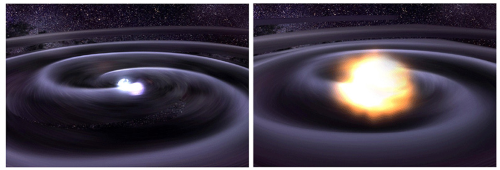
Illustration of two black holes spiralling into each other to create a larger black hole. (Courtesy: Caltech/MIT/LIGO Lab)
By Hamish Johnston
Physicists working on the LIGO gravitational-wave detectors have released more information about the merging black holes that they announced the discovery of earlier this year. Dubbed GW150914, we now know that the gravitational wave was created by the merger of one black hole that was 36 times as massive as the Sun with a smaller black hole that weighed in at 29 solar masses. The result of the merger was a black hole at 62 solar masses and a spin angular momentum of 0.67, where 1.0 is the maximum value of spin a black hole can have.
According to the team, the black hole created by the GW150914 merger is the largest “stellar-mass” black hole known to astronomers. This doesn’t include the much larger supermassive black holes that are known to inhabit the centres of most galaxies.
LIGO scientists have also calculated that the collision occurred about 410 MPc (about one billion light-years) from Earth and GW150914 is likely to have come from the southern sky.
If you want to know more, the analysis is presented in a paper in Physical Review Letters: “Properties of the binary black hole merger GW150914”.
Quote from reference(96)of the paper:”we find no evidence for violations of general relativity in the genuinely strong-field regime of gravity.” Important result showing that one can use the “numerical gravity” to deal with the GW’s emitted in a strong gravitational field region.
Cool